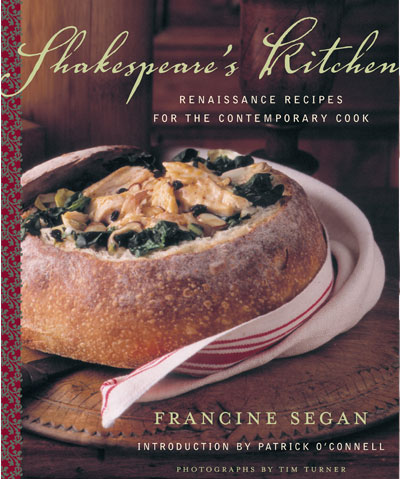Shakespeare's Kitchen
Ricette rinascimentali per una cucina contemporanea
La maggior parte dei capitoli di Shakespeare's Kitchen racconta di un particolare scrittore di cucina del periodo elisabettiano. Nel capitolo Basic, si potrà incontrare l'autore di libri di cucina, poeta e inventore Sir Hugh Platt che fu nominato cavaliere da Re James I per le sue innovazioni in agricoltura. Nel capitolo Dessert si conoscerà Sarah Longe che condivide ricette piaciute sia alla Regina Elisabetta che a Re James e nel capitolo Appetizer si potrà conoscere Gervase Markham il cui libro di cucina del 1615 iniziava così: "Mangiare e bere sono un'invenzione molto carina". Permettetemi di presentarvi questi straordinari cuochi elisabettiani, le loro ricette, il cibo e i costumi legati ai pranzi del Sedicesimo e Diciassetesimo secolo, come in un viaggio indietro nel tempo tra l'Inghilterra di Shakespeare e le nostre radici culinarie.

Saturday, May 8, 2004
"It was hard to miss the peacock in the ballroom of the Pierre Hotel…but the main attraction on Monday night…was the food, all updated versions of Elizabethan recipes by Francine Segan, author of Shakespeare's Kitchen: Renaissance Recipes for the Contemporary Cook (Random House, 2003) and the culinary advisor for the evening."

April 2, 2004
"Ms. Segan, like some historically minded chefs and cookbook authors, is willing to sacrifice some authenticity for popular appeal. In a recipe for Cornish game hens with sage she instructs readers to use an oven rather than boil the meat in a cheesecloth. She also substitutes marjoram for the herb hyssop, popular in the Tudor era but hard to find in the U.S. these days. Sometimes it takes more than switching a few spices to save a dish from the culinary compost heap. In her recipe for "courage tart," a sweet-potato-and-apple pie widely used as an Elizabethan aphrodisiac, Ms. Segan excluded sparrow brain. And she decided against a chapter on how to cook "head of beast."
» Buy This Book
